There are certain constants that one can rely on when attending camel wrestling: The booze is always flowing, the camels are consistently covered in colorful garb and assigned equally colorful names, such as Arab Şimşek (Arab Lightning), and the camel sausage, which hangs down like curtains around each vendor’s stand, never runs out.
The camel wrestling festival in Selçuk, which is held on the third Sunday of each January, is one of many camel wrestling competitions that take place up and down the Aegean coast of Turkey from roughly November to March. As an American living in Istanbul, the annual trip to Selçuk has become a winter pilgrimage of sorts. Except instead of escaping the bleak cold of winter to bask in the sun — the winter ritual during my childhood in New England — we trade in the tall buildings and cramped streets of Istanbul for a smoky pit nestled between fields dotted with ruins and a deserted summer resort village.
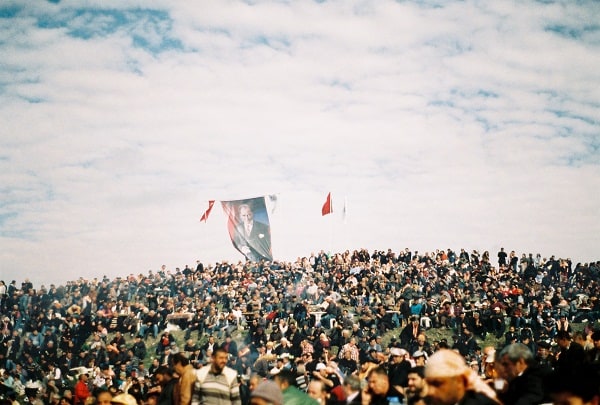
The celebration feels at once so familiar and so surreal. Arriving to the grounds around 9:00 a.m., long before the first match begins at 11 a.m., my husband and I find almost every square inch of the earthen amphitheater claimed by folding chairs, card tables and smoking grills; it looks like the place is on fire. We put our plastic stools, bought at the entrance, at the back of one level, with grills both in front of us and towering behind us. The camels have only just started arriving and, despite the early hour, bottles of rakı are already half empty.
Convening a group to attend camel wrestling has never been much of a challenge. The prospect of two camels duking it out — which ends up looking more like two camels fondly necking — is so alien that most expats jump at the chance to view it in person. My first trip to camel wrestling in 2013, there were four of us. The following year we were a group of twelve, and this year twenty of us made the trek from Istanbul to Selçuk.
I’ve often been asked by Turkish friends why I keep going back. To many of them, camel wrestling is nothing more than an oddity, something to experience only once, if at all. The appeal can be difficult to explain without sounding like an Orientalist or a lush. You would think that after being questioned so many times, I would have a go-to answer, but I don’t. As we prepared for our third annual journey, I couldn’t help but wonder: Why do I keep returning to Selçuk each January?
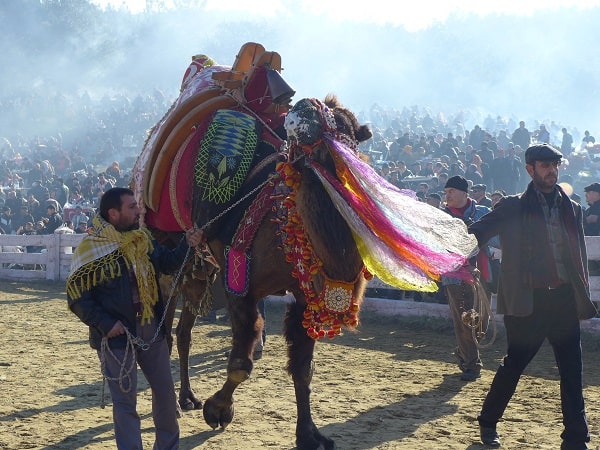
There are the camels themselves, for starters. With tapestries of bright blues, pinks, yellows and greens draped over their backs, they saunter into the event grounds one after another. They move at whatever pace they prefer, some running and others stopping mid-procession, the spit from their frothy mouths trailing behind them and landing on some unsuspecting spectator. Their arrival is announced by chiming bells, which are strung across their harnesses in a way that is oddly reminiscent of reindeer. While waiting for their time in the ring, they laze about in an open field next to the toilets, with their back legs locked in the shape of a precarious-looking triangle.
Yet the wrestling is almost farcical; camels can be quite obstinate. During the initial parade around the ring, numerous camels drop down to the ground and begin rolling around in the dirt, which makes them appear more like pussy cats than fighting animals. One of our neighbors explains that the handlers can direct the camels, but once the beasts decide to lay down, almost nothing can be done to set them upright again. This same rebellious streak can also be seen in the wrestling matches. Although there are some intense scuffles between the lanky beasts, who are primed to fight by smelling a female camel in heat, it’s not uncommon for one camel to gallop out of the ring soon after the start of the match.
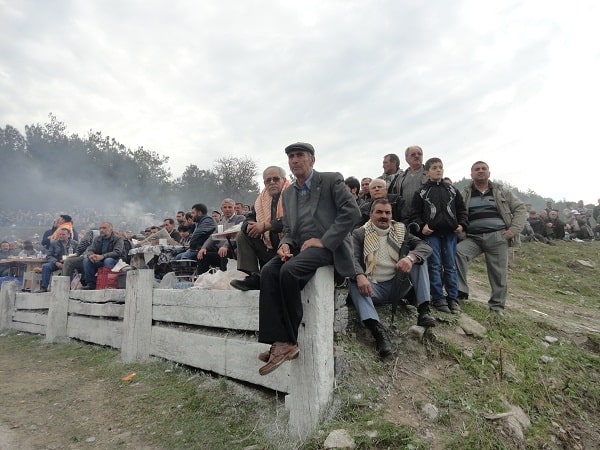
Halfway through the day, it becomes less about the camels and more about the crowd. The attendees of camel wrestling are overwhelmingly male and, surprisingly, a large number are wearing variations of the same outfit — grey trousers, a grey vest and tall, black leather boots with a pleated section at the ankle that I can only describe as accordion-like. This seemingly painstaking coordination threw me off at first, until I was clued in to the fact that this was the attire of an efe (also called a zeybek). Efe, a common Turkish name that more generally connotes a brave and honest man, is also a term used to describe a particular type of man from western Anatolia. According to folklore, these men threw off the yoke of oppressive authority and took to the mountains after committing acts that were deemed punishable by those in power. In spite of, or more likely due to these acts of rebellion, they were admired by their communities, and occupied a meaningful, if slightly marginal place in the larger national narrative.
True, not every man is dressed in this way; not all outwardly identify as an efe, but most carry themselves with the same confidence. Some pose for photos with the gravitas and dignity of a man sure of his place; others delicately peel tomatoes and tend to their grill with a deftness and certainty, patiently waiting until each component is complete before putting together the perfect sandwich with their calloused hands. When a roving pair of musicians comes around, one on a large drum (davul) and the other on a zurna, a high-pitched reed instrument that one could almost mistake for a duck at times, someone from each group invariably attempts the zeybek dance, his chest held high.
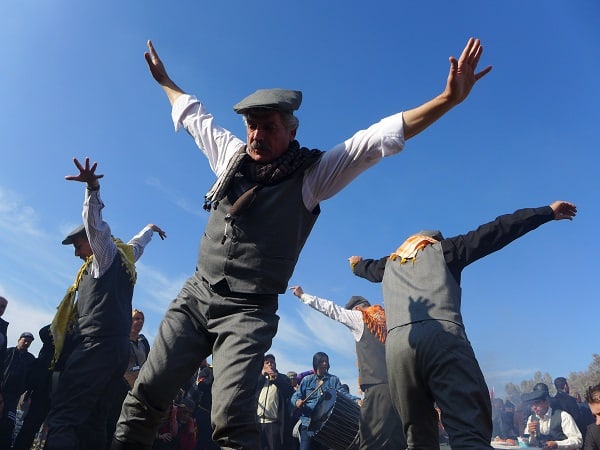
If I’m honest with myself, it’s these men that keep me coming back to camel wrestling each year. I am both in awe of and curious about their past, the stories they have been told and the stories they themselves tell. How watching these camels wrestle is just one part of a larger narrative surrounding their history, both individual and shared. But at the same time, a creeping self awareness (and years of history classes) prevents me from mythologizing this group of Turkish men who happen to be gathered together in a hazy pit one Sunday in January.
Sure, the siren of nationalism and folklore is tempting, and it’s easy to indulge in the belief that somehow these men are timeless, authentic Turks — whatever that may mean. But to me, it’s not a question of authenticity, of camel wrestling being some sort of unique and representative aspect of Turkish culture. Whenever someone speaks of authenticity in travel, I often find that this sentiment is steeped in preconceived notions of the “other” or the exotic. Aren’t all places and people their genuine selves, even when they are actively trying to imitate someplace or someone else? (Las Vegas comes to mind.) What makes something more or less “authentic” is generally tied to some misguided notion in our minds of what these people or those places are like — almost in a primal sense — and how close the reality fits this imagined ideal.
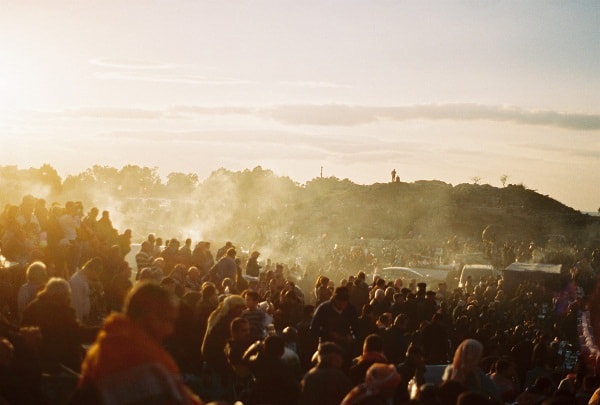
So it’s important to recognize that even though a national or legendary narrative may shape reality, it is still just a narrative and not one that everyone subscribes to. Despite the similarities of these men at the camel wrestling festival, they are by no means a monolith. They are not some mythical men of the past, here for our viewing pleasure. Some come for the camels, some for the dancing and others for the day drinking. Some will share their stories of an efe heritage, while others grip selfie sticks and share horror stories of Istanbul traffic. But they are almost always welcoming to a group of foreigners. And that bottle of rakı on the table? They’re already pouring you a glass.
Featured Image Source: Katie Nadworny. Many thanks to both Katie, whose work you can see on her blog Katrinka Abroad, and Emilie, whose work you can see on her blog figs and peaches, for the wonderful photography.
Emma Harper is a contributor to Yabangee. She has previously written about camel wrestling and the history of the ‘efe’, which you can read here. You can find her struggling to stay within the 140 character limit on Twitter @emineharper.












I really must go. I love camels, early mornings and colour, in all its forms. A nice piece.